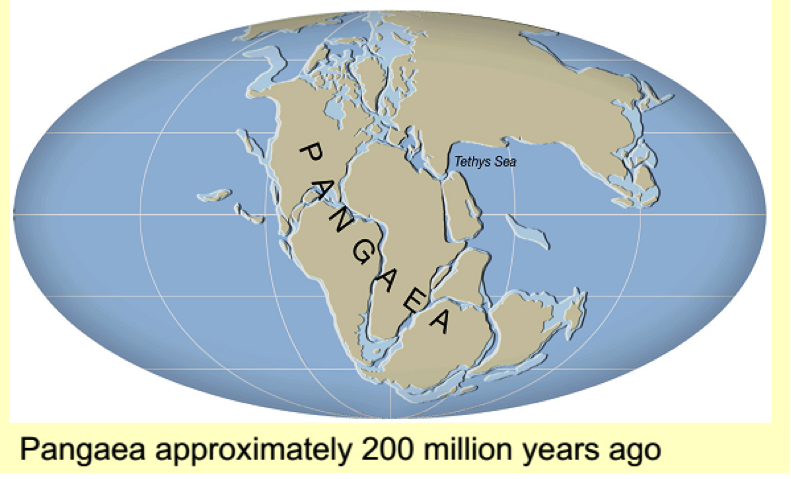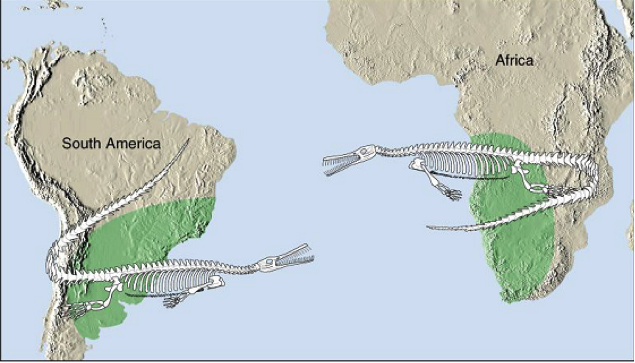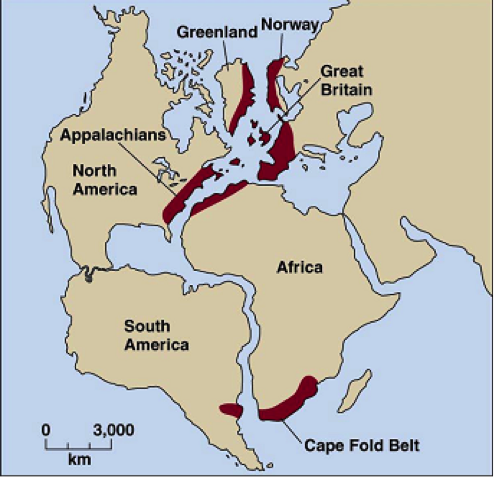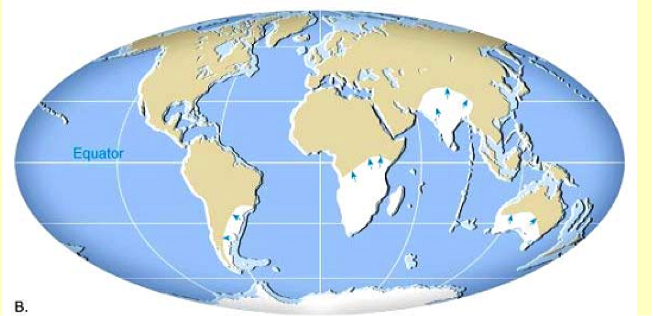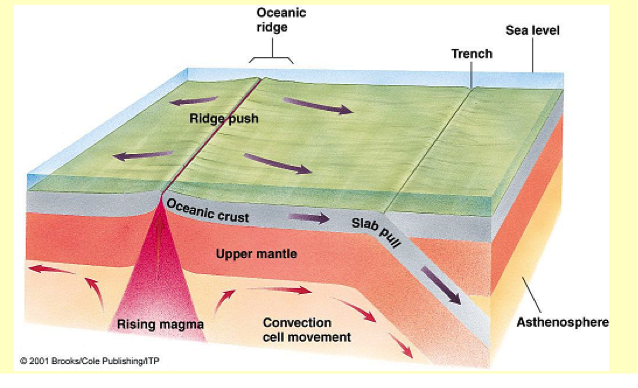Difference between revisions of "Continental drift"
Cwhitehurst (talk | contribs) |
Cwhitehurst (talk | contribs) |
||
| (8 intermediate revisions by 2 users not shown) | |||
| Line 1: | Line 1: | ||
| − | + | {{Wiki Write Off Entry | |
| − | + | |image=AAPG-WIKI-Write-off.jpg | |
| − | Based on the works of | + | |student chapter=University of Ilorin |
| + | |competition=December 2014 | ||
| + | }} | ||
| + | Based on the works of geologists over the years, it has been shown that lithospheric plates move. This movement also serve as evidence of the active nature of the earth. Continental drift is a principle that explains the current position of the earth's lithospheric plate. This principle was put forward by Alfred Wegener in 1915 when he observed that the earth plates will fit together like a puzzle with other supporting evidence. He called the whole mass Pangaea, which means all land. This principle was not agreed upon by all geoscientist at this time, because Wegener was unable to give the reason for what causes the plates' movement. | ||
==Evidence== | ==Evidence== | ||
| − | [[File:Continental Drift Fig-1.png|thumb|300px| | + | [[File:Continental Drift Fig-1.png|thumb|300px|{{figure number|1}}]] |
| − | The evidence given by Wegener | + | The evidence given by Wegener was: |
* Fit of the continents: Wegener noted that if the continents where to be fitted along there margins, they will fit into a whole mass called the Pangaea. | * Fit of the continents: Wegener noted that if the continents where to be fitted along there margins, they will fit into a whole mass called the Pangaea. | ||
| − | [[File:Continental Drift Fig-2.png|center| | + | [[File:Continental Drift Fig-2.png|center|framed|{{figure number|2}}]] |
* From fossil records: Wegener noted that some of the tropical plant fossils that where once located at the equator are now found in the Antarctica e.g Glossopteris. Fossils of the reptlile Mesosaurus are found in Africa and South America. Wegener felt that if this animal was a good swimmer to cross the Atlantic then its remains should be widely distributed. But it is not. | * From fossil records: Wegener noted that some of the tropical plant fossils that where once located at the equator are now found in the Antarctica e.g Glossopteris. Fossils of the reptlile Mesosaurus are found in Africa and South America. Wegener felt that if this animal was a good swimmer to cross the Atlantic then its remains should be widely distributed. But it is not. | ||
| − | [[File:Continental Drift Fig-3.png|center| | + | [[File:Continental Drift Fig-3.png|center|framed|{{figure number|3}}Mesosaurus in Africa and south America]] |
| − | * Rock type and structure: he also noted that the rocks that were found on one side of a continent are similar to those found on the other. This is also applicable to the structures, including sedimentary, metamorphic and igneous structures. Also, mountain ranges of similar ages are found on opposite side of two continental plates. | + | * Rock type and structure: he also noted that the rocks that were found on one side of a continent are similar to those found on the other. This is also applicable to the structures, including sedimentary, metamorphic and [[igneous]] structures. Also, mountain ranges of similar ages are found on opposite side of two continental plates. |
| − | [[File:Continental Drift Fig-4.png|center| | + | [[File:Continental Drift Fig-4.png|center|framed|{{figure number|4}}Continental plates showing rock types]] |
* Paleoclimatic evidence: there is a range of evidence that shows that area that where once covered by ice are now tropical. | * Paleoclimatic evidence: there is a range of evidence that shows that area that where once covered by ice are now tropical. | ||
| − | [[File:Continental Drift Fig-5.png|center| | + | [[File:Continental Drift Fig-5.png|center|framed|{{figure number|5}}Continents as they are today showing areas where evidence of ancient ice sheets exist.]] |
| − | + | Evidence given by others: | |
* Rocks of the ocean floor were sampled and found to be geologically young (<200Ma), very young at the mid ocean ridge and progressively older away from it. | * Rocks of the ocean floor were sampled and found to be geologically young (<200Ma), very young at the mid ocean ridge and progressively older away from it. | ||
* The seafloor spreading hypothesis was proposed by Harry Hess in the early 1960s. | * The seafloor spreading hypothesis was proposed by Harry Hess in the early 1960s. | ||
==Causes== | ==Causes== | ||
| − | Various earth scientist have proposed the cause for continental drifting. One of the main | + | Various earth scientist have proposed the cause for continental drifting. One of the main causes is explained by [[plate tectonics]], which proposed that the plates move by the convective flow of [[mantle]] material. Some related mechanism are the ridge push and slab pull. |
| − | [[File:Continental Drift Fig-6.png|center|frame| | + | [[File:Continental Drift Fig-6.png|center|frame|{{figure number|6}}]] |
==See also== | ==See also== | ||
| Line 36: | Line 39: | ||
==Sources== | ==Sources== | ||
| − | * Montgomery, C.,Fundamentals of Geology, 3rd Ed. | + | * Montgomery, C., 1997, Fundamentals of Geology, 3rd Ed.: William C. Brown Publishers, Chicago, IL. |
| − | * Murphy, B. and Nance, D.,Earth Science Today | + | * Murphy, B. and Nance, D., 1999. Earth Science Today: Brooks/Cole Publishing Co., Pacific Grove, CA. |
| − | * National Academy of Sciences for the American Geological Institute,Dictionary of Geological Terms | + | * National Academy of Sciences for the American Geological Institute, 1962, Dictionary of Geological Terms: Dolphin Reference Books Edition, University of California Press. |
==Useful links== | ==Useful links== | ||
| Line 44: | Line 47: | ||
* [http://www.enchantedlearning.com/subjects/dinosaurs/glossary/Contdrift.shtml Paleontologic support] | * [http://www.enchantedlearning.com/subjects/dinosaurs/glossary/Contdrift.shtml Paleontologic support] | ||
* [[Wikipedia:Continental drift|History of proposal, rejection, and acceptance]] | * [[Wikipedia:Continental drift|History of proposal, rejection, and acceptance]] | ||
| − | |||
| − | |||
Latest revision as of 20:31, 11 March 2016
| Wiki Write-Off Entry | |
|---|---|

| |
| Student Chapter | University of Ilorin |
| Competition | December 2014 |
Based on the works of geologists over the years, it has been shown that lithospheric plates move. This movement also serve as evidence of the active nature of the earth. Continental drift is a principle that explains the current position of the earth's lithospheric plate. This principle was put forward by Alfred Wegener in 1915 when he observed that the earth plates will fit together like a puzzle with other supporting evidence. He called the whole mass Pangaea, which means all land. This principle was not agreed upon by all geoscientist at this time, because Wegener was unable to give the reason for what causes the plates' movement.
Evidence
The evidence given by Wegener was:
- Fit of the continents: Wegener noted that if the continents where to be fitted along there margins, they will fit into a whole mass called the Pangaea.
- From fossil records: Wegener noted that some of the tropical plant fossils that where once located at the equator are now found in the Antarctica e.g Glossopteris. Fossils of the reptlile Mesosaurus are found in Africa and South America. Wegener felt that if this animal was a good swimmer to cross the Atlantic then its remains should be widely distributed. But it is not.
- Rock type and structure: he also noted that the rocks that were found on one side of a continent are similar to those found on the other. This is also applicable to the structures, including sedimentary, metamorphic and igneous structures. Also, mountain ranges of similar ages are found on opposite side of two continental plates.
- Paleoclimatic evidence: there is a range of evidence that shows that area that where once covered by ice are now tropical.
Evidence given by others:
- Rocks of the ocean floor were sampled and found to be geologically young (<200Ma), very young at the mid ocean ridge and progressively older away from it.
- The seafloor spreading hypothesis was proposed by Harry Hess in the early 1960s.
Causes
Various earth scientist have proposed the cause for continental drifting. One of the main causes is explained by plate tectonics, which proposed that the plates move by the convective flow of mantle material. Some related mechanism are the ridge push and slab pull.
See also
Sources
- Montgomery, C., 1997, Fundamentals of Geology, 3rd Ed.: William C. Brown Publishers, Chicago, IL.
- Murphy, B. and Nance, D., 1999. Earth Science Today: Brooks/Cole Publishing Co., Pacific Grove, CA.
- National Academy of Sciences for the American Geological Institute, 1962, Dictionary of Geological Terms: Dolphin Reference Books Edition, University of California Press.

